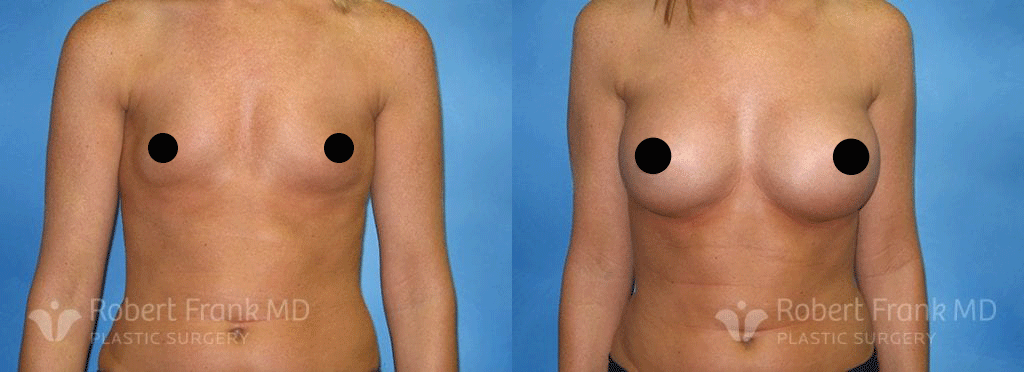
Robert Frank, MD Plastic Surgery has extensive experience helping women from Munster, Hobart, Crown Point, and Frankfort achieve fuller, more youthful, and more symmetrical breasts. Dr. Frank’s methodical and supportive care ensures that patients are involved in their treatment and feel confident at every stage in the process.
Breast augmentation patients choose the procedure for one of several reasons. Most commonly:
- Patients want to regain the fullness they have lost following weight change, childbirth, or breastfeeding, all of which can create a deflated appearance.
- Some women have never had significant breast volume. Surgery can allow them to achieve a fuller and more proportionate appearance.*
The women who choose our practice are seeking natural-looking, attractive results that are a proper fit for their frame. Learn how Dr. Frank provides these results as well as an excellent patient experience.*
Dr. Frank’s Approach to Breast Augmentation
From the initial consultation to the final recovery check-up, Dr. Frank works to give you a comfortable and successful augmentation experience. It is here where Dr. Frank and you will determine which breast implants and surgical technique will best match your goals.
Initial Consultation
It is important for patients to hear about surgery from the person conducting the procedure. That’s why breast augmentation patients from Munster, Hobart, Crown Point, and Frankfort meet with Dr. Frank—not a patient coordinator—to learn what to expect and to ask their questions about treatment.
At the end of the consultation, patients receive a price quote for everything excluding postoperative medications. While some practices offer a price for surgery alone—which ignores other costs such as surgical bras, facility charges, and anesthesia—our patients know the bottom line before they make their decision.
Second Visit
In a second visit, breast augmentation patients complete consent forms, learn about the recovery process, take preoperative photographs, and complete a sizing session. During the sizing, patients assess their goals by trying sizer implants in a bra. This gives women a chance to see the difference 50 or 100 ccs can make in their final appearance. Patients who previously had surgery elsewhere tell us that this approach to sizing is more effective than what they experienced before. Dr. Frank offers guidance in the process and invites patients to return before surgery to confirm their decision if they wish.
Implants and Breast Augmentation
Patients typically have a lot of questions about implants. In brief:
We use Mentor® and Inamed® implants. All three manufacturers stand behind their products with generous warranties and have proven their safety over time.
About 85% of Dr. Frank’s breast augmentation patients elect to have silicone gel implants, which have been FDA-approved for all patients since 2008. They offer a softer, more natural feel.*
Dr. Frank generally places implants under the muscle to provide a more natural postoperative appearance, limit capsular contracture (scar tissue formation), and reduce concerns with mammograms and breastfeeding.*
Breast Augmentation Before and Afters

*Individual results may vary
About the Procedure
Dr. Frank performs all anesthesia-based procedures at a licensed, JCAHO accredited, surgical facility in the vicinity of Hobart and Munster. Breast augmentation patients receive general anesthesia so that they are comfortable through the procedure.
Dr. Frank places incisions either around the areola or underneath the breast depending on the patient’s goals and body type. These surgical approaches help prevent asymmetry and make follow-up procedures easier. This is important since many women will need implant replacement at some point over the course of their lives.
Incisions are typically well concealed and closed with dissolving sutures that do not need to be removed. Because Dr. Frank uses the Keller Funnel™, he can create much smaller incisions, even for large implants, and provide patients with an easier recuperation.*
Recovery from Breast Augmentation
Dr. Frank’s patients benefit from an epidural catheter placed in the pocket created for the implant and loaded with local anesthesia, which makes for a more comfortable wakeup. This anesthetic allows them to return home and begin their medication without a significant lapse in their pain management.*
Our practice usually sees breast augmentation patients the day after surgery for a check-up and then at one week, one month, and two months after the procedure. Additionally, Dr. Frank welcomes patients to contact and visit the practice as needed during their recovery for no additional fee. His priority is the comfort, safety, and satisfaction of those he treats.
- During their recovery, patients take narcotic pain medication for 3-5 days and can return to work within 7-10 days.*
- It takes about 4-6 weeks for the breasts to settle. Patients may notice asymmetry before this time.*
- After about six weeks, patients can return to more physical activities, including working out.*
Dr. Frank’s Advice on Recovery
We all have our own ideas of how long recovery should take. Unfortunately, this means many patients try to rush their recovery and go back to normal activities. This trend is especially true among young mothers who want to spend every moment with their children. They may attempt to play with or pick up their children before their bodies are ready to handle that strain.
Dr. Frank sees rushed recoveries in several ways, with one of the most common being pain. Patients who try to be too active too early in the recovery process often find themselves running through their pain medication too soon and have to ask for an early refill. Rather than increase the amount of medication you take, you will feel better sooner and end the period wherein you need the medication faster if you allow your body to rest. Do not force your body to undergo more physical strain than it is ready to handle. It is okay to take 30-minute breaks on the couch.
Another way Dr. Frank sees patients push themselves too hard is an increased risk of both swelling and dangerous hematomas.
For example, after liposuction, your body needs time to move fluid out of your skin. Patients who have had liposuction will have skin that feels firmer than untreated areas because of this fluid buildup. Getting that fluid out of your skin is one of your recovery goals during the weeks after surgery. But if you activate your muscles near the treated area, that activity draws fluid into the area, which increases swelling and often pain. In the case of a tummy tuck, too much activity early in your recovery can increase blood pressure, which then causes more oozing into the space created during surgery. While a little fluid is normal, it’s easy to overwhelm your body’s ability to absorb this fluid. A hematoma is the result.
To minimize these concerns, Dr. Frank encourages all patients to clear their schedules of everything except the most essential duties for the two weeks after surgery. You should minimize the amount of childcare, job responsibilities, meetings, social activities, and home chores in which you partake so your body can rest. You will feel better and recover faster if you plan ahead so that your body, not your calendar, determines when you are ready for your physical activities.
Patients from Munster, Hobart, Crown Point, and Frankfort can schedule a breast augmentation consultation with Robert Frank MD, Plastic Surgery by calling (219) 513-2011. You can also schedule your appointment with our online form.

